#Waterproof knitted fabrics
Explore tagged Tumblr posts
Text
Waterproof knitted fabrics Manufacturers
What is Waterproof knitted fabrics:
Waterproof knitted fabrics are fabrics that have been treated or coated in some way to make them resistant to water.There are several different methods that can be used to make knitted fabrics waterproof, including coating the fabric with a waterproof layer, laminating it with a waterproof film, or knitting it using waterproof yarns.Waterproof knitted fabrics can be made from a variety of materials, including synthetic fibers such as polyester and nylon, as well as natural fibers such as wool and cotton. Each type of material may have different properties and characteristics, such as stretch, durability, and breathability.They are used in a variety of applications, including outdoor clothing, gear, and other items that need to be able to withstand wet conditions. Advantages of Waterproof knitted fabrics:
Waterproof knitted fabrics are highly durable and can be an effective way to protect against the elements in a variety of settings. They are typically made of synthetic materials, such as polyester or nylon, and can be used in a variety of applications, including outdoor gear, rainwear, and protective clothing. Some characteristics of waterproof knitted fabrics include:
Easy to care for: Waterproof knitted fabrics are usually easy to care for and can be washed and dried like other fabrics.
Water repellency: Waterproof knitted fabrics are able to repel water and prevent it from soaking into the fabric.
Breathability: Some waterproof knitted fabrics are also breathable, meaning that they allow water vapor to pass through them, helping to keep the wearer cool and comfortable.
Water repellent finish: Many waterproof knitted fabrics are treated with a water repellent finish, which helps to prevent water from soaking into the fabric. This finish can be applied to the surface of the fabric or integrated into the fibers themselves.
Stretch: Many waterproof knitted fabrics have some degree of stretch, which can make them more comfortable to wear and allow for a greater range of movement.
Durability: Waterproof knitted fabrics are often made from strong and durable materials, such as polyester or nylon, which can withstand wear and tear.
Lightweight: Some waterproof knitted fabrics are designed to be lightweight, making them easy to pack and carry.
Easy to care for: Many waterproof knitted fabrics are easy to care for and can be washed and dried without losing their waterproof properties.
0 notes
Text
My dear lgbt+ kids,
When it comes to cold weather, the main rule (regardless of gender or presentation) is: when in doubt, choose warmth and safety over style.
Some basics:
Layering is your best friend: Start with moisture-wicking base layers to keep sweat off your skin. Follow with insulating layers (like fleece or wool), and finish with a weather-resistant outer layer (like a puffer jacket or waterproof coat) to protect against wind, snow or rain.
Keep your sensitive areas warm: Make sure your hands, feet, and head are covered! Gloves, warm socks and a beanie can prevent cold-related discomfort or injuries.
Waterproof: If you're facing snow or rain, make sure your clothes are waterproof. Wet clothes lose their insulating ability, so staying dry is a big part of staying warm!
Reflective Gear: If you’re out in the dark or in poor visibility conditions, consider adding reflective elements to your outfit for safety.
People can react differently to temperatures. A temperature that feels super cold to you could feel comfortable to someone else, depending on what you’re used to (and some other factors). As a very basic rule, we can say: Gloves, beanies, and other cold-weather accessories typically become necessary when temperatures drop below 40°F (4°C). In more severe cold (below 32°F (0°C)), it’s even more important to wear them to protect yourself from frostbite and maintain body warmth. But it goes even in milder weather: if you feel uncomfortable or if it’s windy or damp, it’s a good idea to add these items for extra comfort.
With all that being said: Clothes are not just for safety and temperature control, they also help you express yourself - and that doesn’t suddenly change in winter.
Dressing for cold weather doesn’t have to mean sacrificing your personal look. Whether you want to present more feminine, more masculine, or more androgynous, here are some tips to help you layer up and feel like yourself:
(Note that these are suggestions, not hard rules. Style is highly subjective as everyone has different tastes, preferences, body types, fashion inspirations, budgets, cultural influences etc. I could suggest something here that you’d feel super uncomfortable in - if so, that’s not a sign you’re “doing it wrong”! Cherry-pick what feels right and ignore the rest)
If You Want to Present More Feminine
Base Layers: If you want to wear skirts or dresses in winter, start with thermal leggings or tights! These can be nicely paired with cozy, long-sleeved tops or lightweight thermal shirts. (But also keep in mind that plenty of women, cis or trans, do not wear dresses all the time! Nothing wrong with choosing jeans!)
Outer Layers: There are plenty of styles to choose from that have a feminine touch, such as a belted trench coat, a pea coat, or a long wool coat. Shawls are also excellent for adding a touch of style while keeping you warm!
Footwear: Knee-high or thigh-high boots lined with faux fur or fleece can keep your legs warm and add a polished look to your outfit. Ankle boots with thicker socks are also a good alternative.
Accessories: Scarves, gloves, and beanies can be both practical and stylish. Knit hats or earmuffs can add a soft, cozy vibe to your look.
Style Tip: Go for a mix of fabrics like wool, faux fur, and knitwear to create texture and warmth.
If You Want to Present More Masculine:
- Base Layers: Start with thermal undershirts or moisture-wicking base layers. Consider long underwear for added insulation beneath your pants.
- Outer Layers: There’s plenty of outerwear to choose from, like a puffer jacket, parka, or wool overcoat! (Faux) Leather or bomber jackets layered over sweaters can also add a masculine edge while keeping you warm.
- Footwear: You might want to opt for sturdy boots, such as work boots, Chelsea boots, or combat boots. Thicker socks can keep your feet warm.
- Accessories: Don’t skip out on scarves, beanies, or gloves for being “too feminine”. They can actually be great for adding a more rugged feel to your outfit! You just gotta find a color and style that fits you well.
Style Tip: Focus on layering in a way that adds structure. Sweaters, button-ups, and jackets work great together for a sharp, put-together look. Play with dark, neutral tones and thick fabrics like wool or denim for extra warmth and style.
If You Want to Present Androgynous
- Base Layers: Neutral-colored thermal tops or turtlenecks can serve as great foundational pieces. You may want to pair these with straight-leg or loose-fitting pants that allow room for layering underneath.
- Outer Layers: Oversized coats, puffer jackets, or long trench coats can work well for an androgynous look. Try layering with oversized sweaters or fleece pullovers for extra warmth.
- Footwear: You could go for sneakers, lace-up boots, or loafers paired with warm, thick socks. But really, any pair of shoes can work for an unisex outfit.
- Accessories: Neutral-colored scarves, simple beanies, and fingerless gloves can add to an androgynous look. Minimalist accessories like oversized scarves or gender-neutral caps are both practical and stylish.
Style Tip: Aim for a balanced mix of structured and relaxed pieces. Try loose layers on top with more fitted pants, or vice versa, to create an effortless, warm, and non-gendered appearance.
With all my love,
Your Tumblr Dad
#I’ll go straight ahead (gay ahead?) and say that fashion isn’t my strong suit#So this is mostly based on internet research#But it was a requested topic and I wanted to do my best to help#lgbt#lgbt+
207 notes
·
View notes
Text
Fabric overview: Neoprene scuba

next up on my favorite fabrics is neoprene scuba! This is a newer fabric to me but once i started using it, i couldnt stop haha.
neoprene scuba is a polyester double knit fabric with a sponge-spacer in between that can vary in size from barely noticeable to 3mm or more. its sometimes referred to as spacer fabric as a result. the term "scuba" can be thrown around a lot, but it typically refers to a thick, double knit poly fabric. It will usually have stretch via the knit weave. (this is something to watch out for, consistency in labeling is worth making note of)

I love neoprene scuba for its ability to hold smooth, defined forms. the thickness is great for smoothing, and the spongey layer gives it a good, shapely body structure. plus the double knit weave creates a soft finish. because of these properties, its my #1 go to for cartoony costumes.
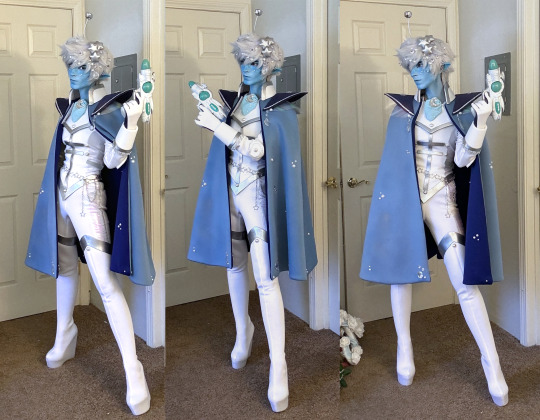
neoprene scuba is also great for bodysuits and form-fitting things as well due to its smoothing properties. I like it a lot for boot covers.
Typically the two main things i use scuba for are bodysuits and capes. Capes for the shape, bodysuits for the smoothing. also it doesnt fray much so I have on occasion left edges raw!
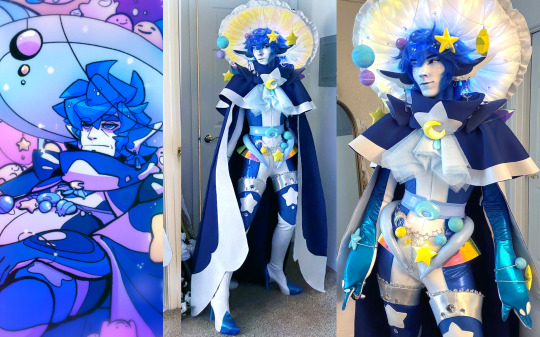
Things to watch out for: 1) as was alluded to, its not easy to shop for. because of the variation in sponge thickness, if youre buying online its not easy to tell if youre getting a thinner, standard double knit or a true spacer scuba. also the terms can be hard to track from neoprene, scuba, spacer, bonded wetsuit fabric, etc. it takes some footwork to find the right fabric. 2) by nature, its a stretch fabric and its not easy to make...unstretchy. this stretch can pose challenges for draping, especially on capes. 3) its heavy and its itchy. no surprise that twice the layers of fabric mean that it can get heavy fast, and the sponge layer is made of little polyester pokers that can irritate the hell out of skin. lining a bodysuit or finishing internal seams is a must. 4) neoprene isnt easy to top stitch. its like trying to top stitch marshmallow. i havent been able to top stitch neoprene in a way that doesnt create a rounded bump effect (which hey, you might even want depending on the application). 5) its a thick heavy fabric, so its another needlesnapper when sewing. also because the dual layers, pressing seams is not always easy. 6) sometimes it has a waterproof finish that makes paining hard, ive also had the sponge layer *literally* suck paint up when trying to airbrush it. (again, think about how applying watery paint to a sponge would go)

despite the downsides, its a fast favorite of mine. what it can do well, it does *so* well. its a special fabric thats akin to sewing with a thin layer of plush marshmallow (as as mentioned...pros and cons to that)
I get my neoprene fabric from big Z mostly, but its also offered at fabric wholesale direct and spandex world. jo anns also has some fascinating scuba suedes that im a big fan of as well. it has a price point between 9-20$ a yard.
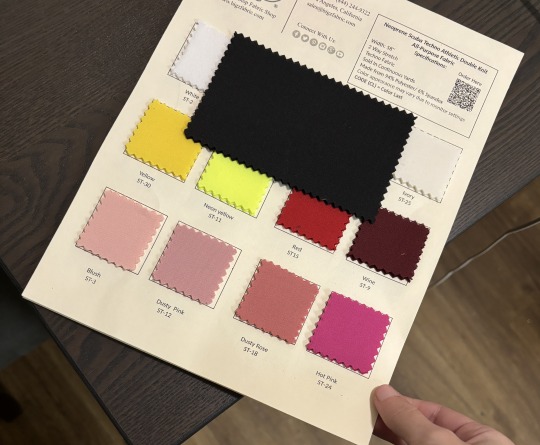
170 notes
·
View notes
Text
Ok I need to word vomit about show Lucy Carlyle as opposed to book Lucy Carlyle. Specifically her wardrobe. Here's a masterpost about the character descriptions in the books, but here's the long and short of it. In the books, Lucy has 3 described outfits:
1. skirt, leggings, padded parka (44) 2. pink and yellow nightie (145) 3. coat, roll-neck sweater, short dark skirt, leggings (169)
Granted, this appears to be just the first book so things may change with her wardrobe later in the series. (Personally I consider her wardrobe in the books to be a symptom of 'adult man writes teenage girl protaganist' syndrome) But in the show there are some notable changes I noticed that I 𝓪𝓭𝓸𝓻𝓮.
Firstly: Her pants. First, pants! She's actually wearing pants to jobs instead of leggings. Considering how much physical activity is required, it never made sense to me that she wore leggings and a skirt to hauntings. The fabric of leggins is too thin so they wouldn't be very warm. Second, a skirt? Lucy is a very practical character, it makes no sense that she would wear something that could get caught on something or grabbed.
But in the show?
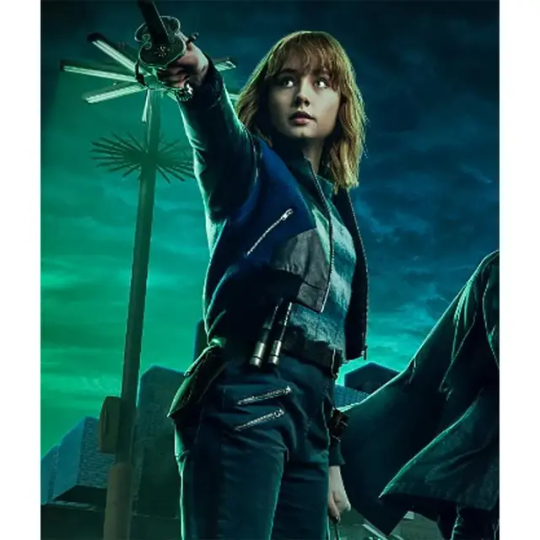
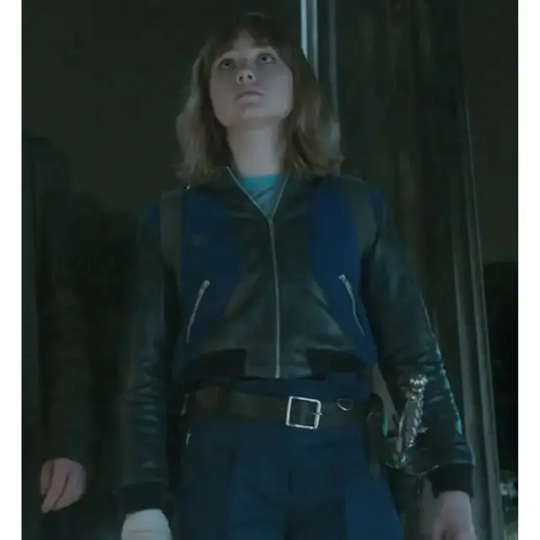
Tactical pants.
The fabric is visibly thick and stiff, a lot like paramedic uniforms. (I'm most familiar with those so there might be better examples) Look at the thick waist, good for possibly having multiple belts or just the way the rapier hangs. I don't see any belt loops but that could be for quick belt release just in case. And the double zip-closed pockets are amazing for keeping gear secure and easily accessible, even if Lucy doesn't seem to be using them. She's probably wearing specifically tactical agent pants. God I love her pants so much, I need a pair.
Second: The jacket. In the books a padded parka or her coat are all very practical choices. But I understand costume designers want their main female character in more appealing-looking clothing or multiple outfits in important scenes for marketing purposes. And I LOVE the bomber jacket.


Firstly, it looks like insulated leather and the blue bits are wool. This is perfect because that gives her a fashionable but practical and warm jacket. The jacket being warm is important because of how often there are temperature drops on jobs, so she needs something to keep her warm. The leather makes it more durable so things thrown by visitors have less of a chance of hitting her. Wool is water repellent and leather is waterproof which in my brain means that ectoplasm wouldn't seep into the fibers and would mean it would have a harder time getting to her skin. Normally I don't like a cropped jacket BUT with how her rapier and other gear sits on her body, a cropped jacket makes all her stuff more easily accessible.
A few smaller details but I love how she has a thick, durable leather belt that would actually be good for holding all her gear. I also really like how she's wearing a knit sweater. Again, she needs to be warm on jobs and it was smart to layer underneath so you can still see the amazing jacket.
I love how the costume designers for the show actually took Lucy's personality into account when making her wardrobe. She has a short temper, she's no-nonsense. So they made her the most practically dressed for her job. It's incredible.
#lockwood and co#lucy carlyle#lockwood & co#lockwood netflix#lockwood books#analysis#costume#costume appreciation#l&co. netflix#l&co#character analysis#rant#word vomit#fashion
54 notes
·
View notes
Text

Lab meeting doodle- been having some Thoughts about Eliksni faces ever since I realized that they don't have nostrils (oops) and I still haven't figured out what the two holes behind the eyes would be useful for. I was thinking that scent gland secretions starts off in a vasaline-like consistancy that then hardens to a more waxy substance to maintain carapace health, much in the same way that the preen gland in many birds keeps feathers waterproof and resistant to damage. The setae also help broadcast the scent to other Eliksni, giving a personal identification tag as well as transmitting information on sex, age, and general health. Humans can't pick up on the smell unless they're REALLY sniffing (or the individual hasn't had a proper scrubbing bath in forever), but to the Eliksni, it's as essential of an identification tool as faces or voices are to people
Behaviorally speaking, these secretions are usually spread across the face and neck by typical grooming gestures, such as swiping the hands over the face and running them through the crest. The scent glands behind the eyes are typically what is used for maintinance of the setae and facial carapace, while those at the end of the muzzle before the eyes are used for scentmarking close kin, friends, mates, and personal items (as the Eliksni nuzzle each other vs kiss). Nuzzling is a very intimate behavior, but it's a little more of a socially widespread gesture than human kissing because of the close-knit nature of Eliksni communities.
As expected, getting these waxy secretions on fabric SUCKS for cleaning, so many Eliksni use eggcloth for facial wrappings, as it's one of the few fabrics where that actually extends the lifespan of the fabric rather than gunks it up, similar to how human skin books actually benefit from being handled often because the oils from people's hands help maintain the leather.
Sensory bristles are more for facial expressions and auditory tracking than a visual aid like in mammals, but some similarities in bristle placement do overlap with whisker placement, like with Earth animals (at the end of the muzzle, over the eyes, etc). Eliksni auditory processing is a complex system that spans several parts of the body: facial bristles in conjunction with their bones and carapace having high vibrational sensitivity merely help them figure out where the sound is originating from, while the ear slits function pretty much as you'd expect them to.
Despite this, Eliksni hearing has a poorer overall range than those of humans, with the pitches they can hear the best being very low-frequency and very high-frequency sounds; everything else in between comes off as somewhat muddled or hard to pinpoint (the lack of subvocals in human language makes tone especially difficult for them). They're also worse at hearing fainter noises than we are. They more than make up for it in terms of having strong vision and a strong sense of smell, however, so don't think you can sneak up on one just because you're being quiet- if their rebreathers are off, they can smell you before they'll ever see you, and they can spot you in the dark with very little issue!
#destiny 2#destiny 2 headcanons#speculative biology#eliksni#eliksni headcanons#my doodles#i looove fuckin around with species that are scent-based#v. underutilized sense and thus v. easy to make a pov character come off as 'alien'#despite humans actually being pretty big on smells ourselves!
32 notes
·
View notes
Text
as i’ve been working on my silly little sky bison post, i’ve been thinking quite a bit about air nomads and fiberworks
i love that one air nomad fiber art post (i’m sure y’all know the one) and i definitely think that pretty much all fabric and fiber used by the air nomads came from their bison. if only because they’d make So Fucking Much of it
not to mention it has quite a bit of cultural backing. yak wool is an extremely important fiber in tibetan culture and they make so many things from it
anyway, just some random thoughts and headcanons that i may or may not expand on later (definitely not doing this because i’m procrastinating on my homework hahaha…):
- bison have a top coat and undercoat, which are used for different things. the top coat fibers are very long and coarse, so they’re best for things like rope, heavy outerwear, saddle pads, and other things that require large but not necessarily comfortable swathes of fabric, like tents, tapestries, etc. the undercoat fibers are much softer and more delicate, so they would be used for clothing, blankets, bedding, rugs, diapers, etc
- with the amount of wool being harvested, they would also have a rather excessive amount of lanolin (a waxy substance produced by animals with wool). it’s extracted when the wool is washed, so it’s a natural byproduct. lanolin has a lot of uses, including but not limited to: waterproofing, cosmetic care such as lip balm, healthcare (could be used underneath bandages to keep a wound moist or mixed with herbs for a topical treatment), diaper rash prevention, and even lubricant (test this one out at your own risk though lol)
- air nomads do a tonnnnn of spinning and weaving. it’s a fantastic way to pass the time on long journeys, a way to use up whatever fur their bison sheds, and even provides them with fiber products to trade or barter with if needed
- a baby bison’s first molt is an incredibly important tradition. the wool is highly prized as it is the softest it will ever be. this event is when a young air nomad learns to work with wool — from start to finish, giving them an appreciation for the craft and it’s importance
- every few years a massive festival is held to celebrate the sky bison and their massive importance to air nomad culture. the nomads spend months creating the most beautiful, intricate, colorful decorations possible to adorn their bison best friends, then participate in a flying parade to show off their hard work (i’m 100% including this in a future fic btw)
- i like to think that while there are techniques shared amongst all air nomads, each temple also has its own fiber “specialty”. like, the northern air temple does knitting, the western temple does crochet, the southern temple does embroidery, so on and so forth. or whatever type of fiber art you want. definitely something i want to do more research on as i’m sure there are tons of other techniques i don’t know about
anyway uh. post dedicated to my new crochet skills 👍
#come play with me in sky bison wool land#please. the air nomad culture in my head. it’s taking over 😭#atla#avatar the last airbender#tlok#the legend of korra#air nomads#atla headcanons
13 notes
·
View notes
Text




So this blocking thing! It's good for more than just nuisances. I haven't knit a lot of garments yet with fiber that responds to blocking, and what I have has been like...socks where it seems unnecessary because the whole thing will be in tension while worn. But also I just don't have large pinnable surfaces, as one typically needs when the point is to soak a piece of fabric and then stretch it out to pose in the shape you want it to be until next soaking. What do I have? The ability to stack waterproof objects on a small patch of flat counter space. And thank goodness because that definitely saved this hat.
Anyway! I am happy to have used my extremely inconsistent first skeins of support-spindled yarn (see the post with them all laid out here) for a project I'll probably actually use once it's chilly again. It is comfortable, even if I'm a bit disappointed in the colorwork legibility. This is how the chart looks:

But I didn't quite manage matching gauge yarns, I'm low on practice/experience keeping tension for stranded colorwork, and probably just aiming for too loose a fabric anyway (should've found a path to increasing stitches and using smaller needles on that section) so it's very blobby.
I do have some of that green and "matching" oyster skein left, as well as a little of the finest oyster yarn I used for the ribbing. So if I use them together again, I'll probably hold the two oyster threads as one. Speaking of, I had way too much of the underplied lace yarn and wasn't happy with my first run at an even more open lace panel, so ended up frogging that back and making these sections with the lace yarn held double. Worth it! Much happier with this result. And I can see why underplied yarn has been said to do lace well; was cool how open it already was before blocking.
Image descriptions below:
[ID: Four photos of a slouchy, off-white beanie with some green colorwork being knit, blocked, and worn. The hat is constructed with a solid top of thicker yarn, strip of lace, a strip of green colorwork (meant to be jumping frogs), a matching strip of lace, and finally a long section of ribbing, broken into four strips by inverting the knits and purls.
In the first photo, with a blurred background, the beanie is still in process with a green string holding the live stitches while it's tried on, partway through the first section of ribbed brim; it fits like a misshapen mushroom, the top lace panel collapsing over the relatively tight colorwork, all under the lumpy increases of the densely knit crown.
The second photo also has a blurred background but shows the hat being blocked, gently stretched over a tower of stacked containers, widest at the top around the curved base of an upside down plastic coffee canister from crown to colorwork, the gradual taper of a hair bleach tub easing the lower lace panel into the ribbing before the very end hangs free around a peanut butter jar pedestal.
The third and fourth photos show the finished hat from the side and front, being worn by a pale-skinned brunette woman with a braid and orange t-shirt in front of painted wood paneling on an overcast day. The hat is slouched but not bulbous, blocking having stretched the colorwork horizontally and the lace vertically; a twice-rolled brim covers the lower lace panel but leaves the still not very legible frog colorwork visible. End ID]
[ID: Chart of green on white colorwork made in the Google Sheets spreadsheet software; a section in the middle is selected, though there are repeated motifs on either side. Every cell with an X in it is colored green and makes slightly horizontally stretched pixel art of a frog hopping from the right to the left; the rightmost frog is crouched under a flower or star made of four dots, to its left is a frog pushing off the ground and to its left a frog leaping horizontally through the air. The repeat is 39 stitches wide, 10 rows tall. End ID]
#cj gladback#knitting#spinning#fashion#sure#took those quick finished photos yesterday just barely out of the rain so no pretty fall leaves to look more cheery#but i wanted to celebrate that the hat fit while i was still excited about the blocking actually working as advertised#not sure who advertised it but no buyers' remorse here
19 notes
·
View notes
Note
beebeebeebee what do they wear when liddle? do they have cute outfits and pjs and comfies? -🪶
grian and gem both wear matchin denim overalls bc i think its funny
okay now for the specifics:
gem rlly just wears her usual kinda stuff. the overalls, tshirts, sweaters, occasional skirt if its summer and shes not doing base work. but i think she coordinates them different? like usually she chooses a bold colour or pattern for one item and the rest just are plain to compliment it. but when little its ALL colours and patterns bc she likes to be a rainbow. also i bet she has a couple pairs of PJs with cute stuff on, like a my little pony matching set and maybe as a joke she got a matching pair of grians creeper PJs to surprise/freak him out one night lol
grian probably dresses the most differently when regressed of all of them. not hugely babyish, but he has hypersensitivity to fabric when little so he wears super soft cotton tshirts - and is more adventurous w them than when big, usually he wears plain ones just a solid colour but when little he might wear ones with polka dots or stripes. maybe one or two with an image on. it becomes obvious he's little bc its quite a difference to his usual outfit. plus he has a SPECIAL red jumper just for littlespace thats almost identical to his regular one but its super soft fluffy fleecy rather than knitted, and has perpetually stretched out sleeves bc he does sweater paws constantly when little (its one of his tells)
etho generally doesnt change clothes when little, wearin his usual shirts and waterproof jackets and his vest and cargo pants. all practical stuff. BUT when he gets little he wont admit that its rlly uncomfy to cuddle up in these and waits for a cg to suggest to him to change into his PJs for the day. he always does so, was kind of waiting to be told to do so (won't admit it but he rlly needs direction when little bc Baby Brain) so he ends up in an oversized tee with comfy sweats or pj pants. nothin special. though his favourite thing to wear - and only rarely does he admit it by asking for it, more often skizz just brings it over and puts it on for him - is one of skizz's hoodies <3 its quite big on etho and is heavy and thick and he wont admit it but he finds so much comfort in the smell of his cg, it all makes him feel so relaxed. plus it feels better to be able to wrap it over his knees when hes curled up, he likes bein swallowed by it... poor baby doesnt realise he's basically swaddling himself
#legg series headcanons#asks#🪶 anon#little gem#agere gem#little grian#agere grian#little etho#agere etho#hermitcraft agere
9 notes
·
View notes
Note
Sights I am so desperate for a crumb of Cricket, can you please do a drabble/hcs of Cricket knitting lil booties for the dogs so they don't get cold toes on their winter walks 🥺
🖤 @slashhinginghasher
I made this special for you.
~~
Booties
A frown creeps across Cricket’s face when Two and Five come in from the back yard delicately stepping and shaking their feet as if in discomfort. Outside, frost coats the walkways and clings to the trees, and a thick layer of snow blankets the lawn. Record low temperatures, the radio had mentioned.
Indeed, when the frigid breeze billows in over the threshold and scatters a dusting snowflakes all over the floor, it chills her to the bone. Pity for the poor hounds settles heavy in her chest. There is no way they can go on their evening walks with Asa without injury to their paws.
An idea forms. When Asa leaves for work, Cricket completes her assigned daily chores in record time. Now, the afternoon is free to devote to her new project.
It is a miracle she has everything she needs: Stretchy fleece fabric in a color Asa won’t detest (she’d used it for making mittens), and leftover waterproof material from the boot covers Asa had asked her to make for…well, she doesn’t want to think too hard about that.
After several hours of trial and error and many fit tests with two very patient dogs, Cricket completes the final stitch just as the front lock clicks. Hurriedly, she slips eight handmade dog booties on eight excited paws. Quiet padding takes the place of clicking nails as the hounds rush to the front door to greet their master.
Cricket rounds the corner, gaze immediately assessing the disapproving crease in Asa’s brow as he stares down at covered dog feet. She waits until he turns his exasperated expression on her before explaining, “I didn’t want them to get frostbite.”
Cold, hard facts. He can’t argue with those.
The Collector’s shoulders rise and fall with his defeated sigh. He tosses the mail on the entryway table and strides away. The dogs still wear their booties.
Cricket takes great care in suppressing her triumphant smile. Today: Boots. Tomorrow: Sweaters.
#thank you for the ask#cricket#cricket oc#asa emory#the collector 2009#the collection#thesightstoshowyou#holy shit I wrote
13 notes
·
View notes
Note
You seem to know a thing or two about wool (and definitely more than I do :D )
Is it possible to use wool in normal fabrics like we use cotton today, or are those too fine to work well with wool?
Because if I could replace some of my cotton T-shirts with ones that have similar properties but are made from wool, that'd be awesome!
(also feel free to post a long ass diatribe about what wool can be used for and what not, I love that shit)
Okay so I'm by no means an expert I just have adhd and knit but the answer to your question is yes but there is a catch.
So wool has finally been having the resurgence it deserves in athletic and technical wear because it already does everything they've been trying to engineer other fabrics to do and poured a ton of money into trying to achieve with synthetics. Wool can keep you cool and keep you warm, it helps regulate temperature and humidity, some sheep produce wool that will absorb moisture off of your body into the fibre itself to wick and achieve evaporative cooling at once while some breeds like Icelandic sheep are entirely waterproof. Wool is amazing! Wool is also stretchy and antibacterial to a degree and just does really well with sweat and body odor in general so it just is a natural fit for athletics and outdoorsmanship.
Because of all this a lot of brands have started to produce wool base layers, tees, and sportswear. Smartwool is an example of a company that's gone all in on wool, but a lot of other companies have small lines of wool garments or one offs.
The problem with most of what is on the market right now is that companies want to make it as easily digestible for consumers as possible. They expect that people aren't going to shell out for the fancy wool tee shirts if the experience isn't the exact same as a cotton tee but slightly elevated. Even if caring for a garment isn't necessarily harder but is just different, generally people won't go for it. Because of this there are two issues I have with how a lot of these are produced.
1. Superwash
Most of these are going to be made with superwash yarns. The websites aren't very clear in listing that but they don't really have to be and most people don't really care about that. Unless you're a fibre artist of some sort you probably don't know or care about what that means so why would they list it?
What they do say is that their garments are machine washable and that you should lay flat to dry. That means that even though these products are listed as 100% wool there is some sort of treatment or coating to seal the scales on the wool and make it so they can survive agitation in the wash and regular detergents.
While I'm not totally against superwash in all contexts and know it has a time and a place for sure I think it's important to recognize that a lot of the properties of wool that we love are achieved BECAUSE of the scales on the wool and when you start messing with those your wool isn't going to perform as well across categories. If you're okay with superwash, then go for it. Just know that your wool isn't going to wool as hard as it could wool.
2. Merino
So merino has somehow become shorthand in recent years for luxurious soft yarn. This isn't totally wrong but it isn't totally right. Merino is probably the most popular bread of wool sheep on the planet. It's heavily used because while the fibre is still relatively cheap it is also very fine and flexible which means it's softer, won't prickle the skin, and can be spun into smaller threads. I think they're some thing like a third of the diameter of a human hair??
While all this is great, it means most of these sheep are coming from industrial farms. If animal welfare is your jam (I hope it's everyone's jam to some degree at least) this is where you're going to start worry about farming practices. Industrial scale farms, even in countries with a lot of protective laws, and where you will have sheep with massive scarring as a means to prevent infection, rough handling, and rougher shearing practices. Now I grew up in a farming area, so I know a lot of things that may seem barbaric actually make a lot of sense in practice, and my roomies family have sheep and have string opinions on which of these practices are important to keep around... but I'm not going to get into that knitty gritty (hehe knitting, get it??).
Outside of animal welfare, when you get into these types of farms shitty shearing and frequent shearing are actually a big issue for wool quality. You see, if you aren't doing a nice smooth shear in one go or are shearing the sheep frequently, you start getting a lot of fibres with shorter than typical staplelengths. While this can mean that some of these fibres are softer because they aren't spending as long being exposed to the elements and sun, it also means that the yarns that are spun up from them will be weaker and more prone to breakage.
Honestly I like merino just fine but it really is the clandestine of the yarns. It does the job and all but it's deeply overhyped by good marketing and has just become the go to because people who generally know textiles but aren't total wool nerds know it will do the job and know it will be recognizable to the consumer as a good material. There are just so many other breeds that produce fibre better suited to all kinds of specific jobs that get passed over for merino and so now passionate hobby farmers and yarn nerds are the only ones keeping all these other breeds alive.
So yea, your tee-shirt will probably still be a great and durable shirt, but the quality won't be exactly what you were dreaming of when you first heard about all the amazing things about wool.

So Yes!!! You absolutely can get wool tee shirts and they will be pretty rad, however they won't be the perfect dream shirt that you imagine when you hear a yarn nerd talk about all of the best properties of wool. I have had wool base layers in the past, and I'm planning on buying a set and a tee that will fit my body these days since I've long grown out of my old ones. Will it be perfect and the most ethical thing? No. Will it be better than something synthetic or a lot of plant based options? I personally think so, but that's for you to decide for yourself:).
#omg i never get asks this is actually the best day of my life#wool#wool nerds rise up#info dumping without citations#ill link some sources later if i remember but my brain is breaking down right now#im supposed to be finishing my degree rn oops in doing this instead
10 notes
·
View notes
Text
This is a plant runner:
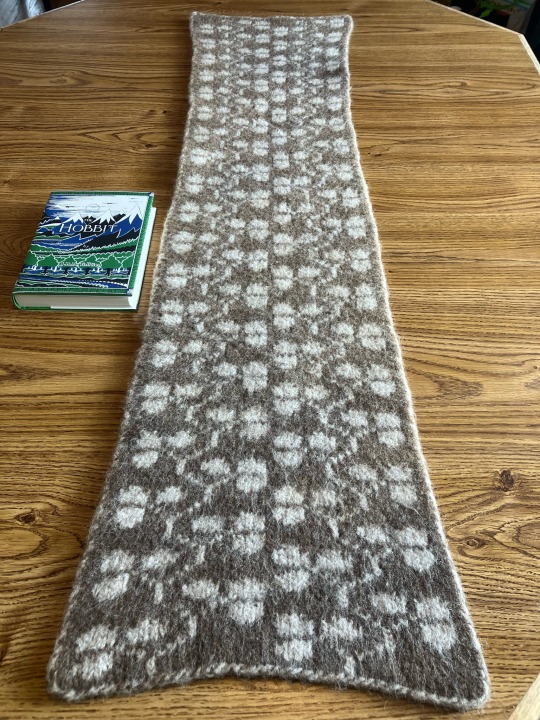

I made it a few years ago. It’s double knit, which is a knitting technique where you cast on stitches that you intend to be on the front of the piece alternating with stitches that you intend to be on the back of the piece and use two balls of yarn in alternating knits and purls to keep some stitches in the front and let som drift to the back, so that you’re basically knitting a giant pocket. You can switch the front and back yarn to make a reversible color pattern.

It’s also felted. Felting is when you take 100% wool yarn and use agitation, heat, or friction to induce the fibers to fuse together, essentially shrinking it on purpose. This makes a much stiffer and sturdier fabric that holds its shape and is more watertight.
This happened because I wanted a plant runner and I thought, “Why don’t more people make double-knit, felted plant runners? I’ve never seen a pattern for one, but it makes so much sense! Double knitting is super flat even with color work, so the pots will be stable, and felted wool is so waterproof that water actually beads on it, so it’ll help with spills. Plus it won’t felt any more in a delicates bag with cold water on a delicate cycle, so I’ll be able to machine wash it. This is a great idea - I’m gonna try it!”
Well, I found out why more people don’t do this, because it was a pain in the neck to make. Because I was shrinking it, it had to be larger than I wanted the finished piece; because it was double knit, I had to do twice as much knitting to get the front and back done; and because of the color work, I had to pay attention to what I was doing the whole time. Most of the time when I’m knitting rectangles like this, I only have to repeat the pattern 3-4 times and it internalizes to the point where I start having an intuitive sense of what to do next and start only having to glance down occasionally to check where I am. I can do complex cables with the TV on and watch the screen most of the time - I’ve knit simpler stuff with an ebook open on a propped screen reading as I go. This thing I had to keep looking at the entire time. Between the double knitting and the leaf pattern, I had to constantly watch what I was doing. This thing took forever! If I calculated out the hours I spent on this as money, there no way I’d spend even a fraction of it on a *plant runner.*
And yet … I had barely finished it when I was already thinking about making another one. You see, I was right. This really does make a fantastic plant runner. It catches the dirt and dried leaves that fall off the plants and keeps them from messing my table, water does bead on it so it protects my table from spills beautifully, and the plant pots sit very stably on it. It’s great!
But I used a kind of wool that comes in several different colors, but is all undyed - it’s from white or brown sheep. I was worried the darkest and lightest colors - that cream that you think of when you hear undyed wool and a dark chocolate brown - would be too much contrast and I went with the second darkest and lightest (a heathered dark brown and an oatmeal off-white). But I forgot how fuzzy wool gets when felted like this and I want a second crack at it with the higher contrast colors to make the pattern pop more. (This is one of the rare cases where the pattern is actually slightly more distinct in photographs than irl.) There’s even a small voice that I think of as, “That is the craft-devil talking,” whispering that I should try it out again with wool yarn that comes in actual colors and see what it looks like as green-and-something.
Fortunately, everyone I know seems to be having babies at the same time, so it’ll probably be 3-5 years before I make anything for myself that isn’t a quick, weekend project between yet another baby blanket.
But every time I wash it, there is that craft-devil. Whispering.
22 notes
·
View notes
Text
KNITTING FABRIC WATERPROOF FOR FITTED SHEET
The company adheres to the "customer first, forge ahead" business philosophy and adheres to the "customer" principle to provide customers with high-quality services.
This kind of fabrics are waterproof first,which are some raw fabric laminated with some different film,such as TPU/PE/PVC/TPFE/PEVA film.At the moment,those fabrics can be functional,flame retardant;antibacterial;the oil resistance and so on.The fabrics’ weight,film specifications,and the composite fabrics’ width are all optional.If you need,we can try our best to do it.

0 notes
Text
DIY Zippered Case
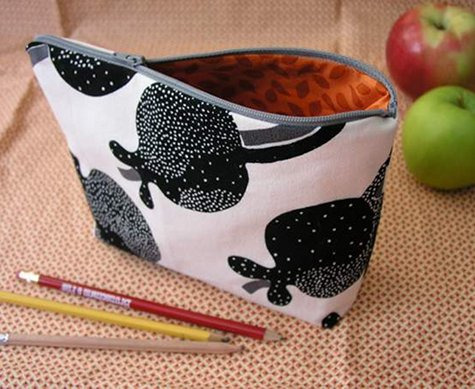
Project by Brett Bara:
It’s back-to-school time, and it’s hard not to have school supplies on the brain even if school days are nowhere in sight for some of us! Inspired by the good old-fashioned pencil case, I thought it would be fun to sew a lined, zippered pouch that you can use for pencils, makeup, electronics or anything else you need to organize and tuck away. The great thing about this bag is that once you understand the basic construction, you can easily make it any size you like. Try a short, long version with a wide base for knitting needles, or a flat bag for electronic cords. You can use oilcloth for the lining to create a waterproof makeup bag, or try stitching a label to the outside to indicate what’s hiding inside. Let’s get started! — Brett Bara

CLICK HERE for the full how-to after the jump!
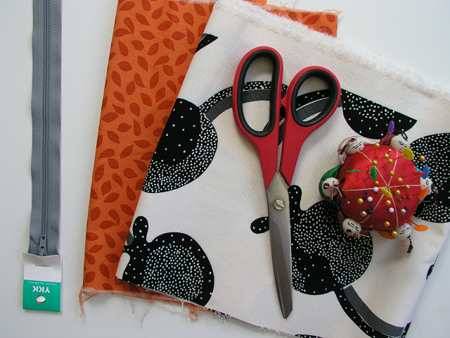
Materials
approximately 1/2 yard of medium or heavy-weight fabric for the bag exterior
approximately 1/2 yard of medium-weight fabric for the lining
standard zipper, at least as wide as your bag will be
scissors
needles
sewing machine
iron
Instructions
1. Cut the fabric.
Decide how large you want your bag to be and cut two pieces of your exterior fabric and two pieces of lining fabric to this size, plus 1″ in length and width for seam allowance. If possible, purchase a zipper that is the same width as your fabric piece or purchase a longer zipper and cut it to size. (Note: if your zipper is only 1 to 2″ longer than your fabric piece, you don’t have to cut it. A small amount of excess zipper length is okay.)
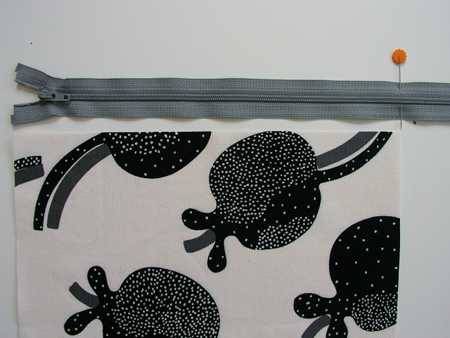
To cut your zipper to size, zip the zipper closed and place the zipper next to your fabric piece, aligning the top end of the zipper with one corner of the fabric. Place a pin in the zipper at the other corner of the fabric piece.

Set your machine to a narrow, short zigzag stitch and sew back and forth across the zipper teeth several times at the point you marked. (Yes, you can sew right across the zipper teeth — your machine can handle it!)
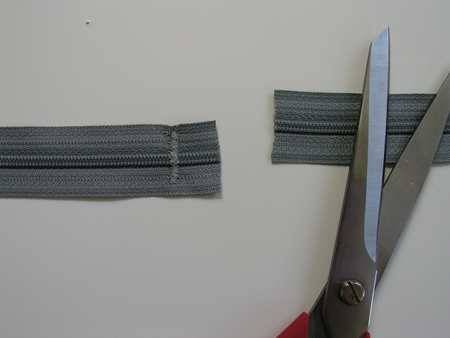
Then cut the zipper about 1/2″ past the spot you sewed. The stitches will act as a stopper on the end of the zipper. And that’s it!
2. Attach the zipper to the fabric.

Place your zipper face down on the right side of one of the exterior pieces and pin it in place.
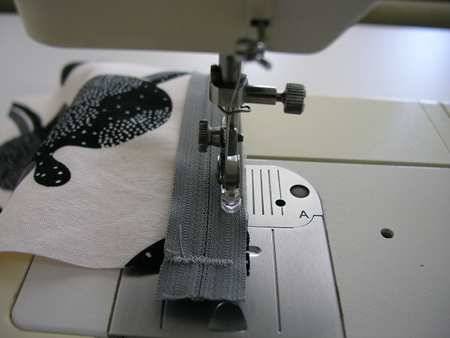
Load your machine with a zipper foot (check your machine’s manual for help with this if necessary) and sew the zipper to the fabric.
3. Attach the lining.
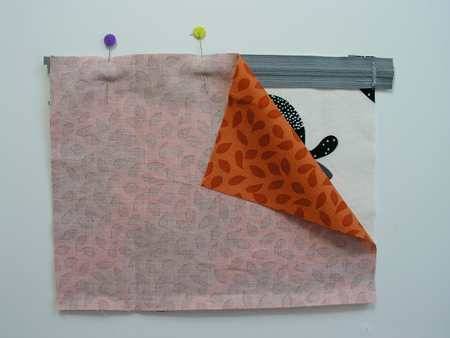
Place the lining right-side down over the zipper and pin it in place. Sew it just as you did the previous piece. (You will be sewing directly over the line of stitching you made when attaching the zipper to the exterior piece. The zipper will now be sandwiched in between the right sides of one lining piece and one exterior piece.)
4. Press the seam.
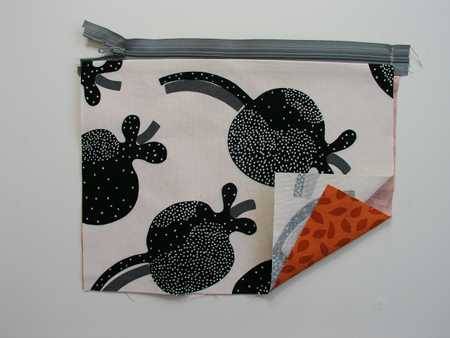
Press the seams you just sewed, folding each piece of fabric back so that the wrong sides are facing each other. (Be careful when ironing near the zipper — after coming in contact with the iron, the metal zipper can get hot enough to burn you.)
5. Attach the next exterior piece.

Place the second exterior piece wrong-side down over the right side of the zipper. Pin it in place, then sew it as you did the other pieces.
6. Attach the second lining piece.

Flip the piece over and pin the lining piece right-side down over the wrong side of the zipper. Sew it in place. The zipper will now be sandwiched between the right sides of the second exterior piece and second lining piece.
7. Iron it flat.
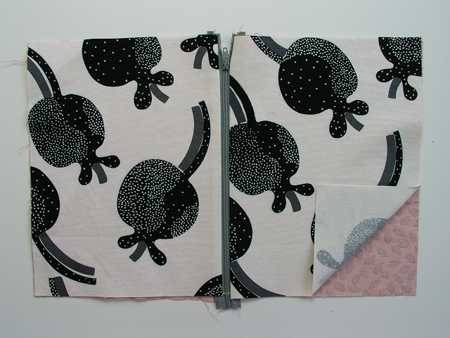
Iron the seams you just made, folding the fabric pieces back so that the wrong sides are facing each other. The resulting piece will have the zipper in the middle, with one exterior piece and one lining piece on each side, and right sides facing out on all the fabric pieces.
8. Fold and sew around the perimeter.
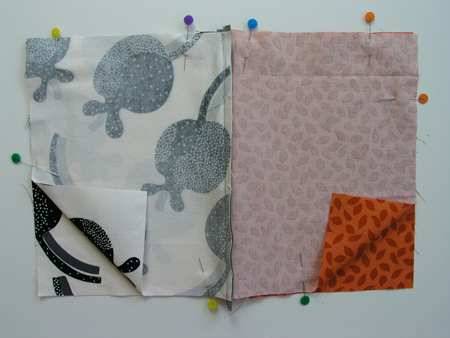
Next, lift each exterior piece and bring them up to meet each other with their right sides together. Also, bring up each lining piece to meet with their right sides together. The zipper will be in the middle. Fold the seam allowance of the zipper toward the lining and pin everything together on all four sides.
9. Sew the perimeter.
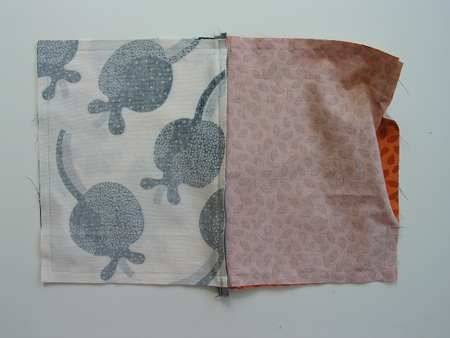
Sew around all four sides of the piece, using a 1/2″ seam allowance and a regular presser foot. Leave an opening of about 4″ on the bottom of the lining side, which will be used to turn the bag right side out.
10. Make the corners.

If you prefer a flat bag, you can skip this step. But if you’d like to make corners to add depth to the bag, here’s how: fold the fabric at the corners so that the side and bottom seams meet. Measure from the point of the corner; here I used a depth of 1″, but if you prefer a deeper bag, just measure further from the corner. Mark the line with a pin.

11. Sew the corners.
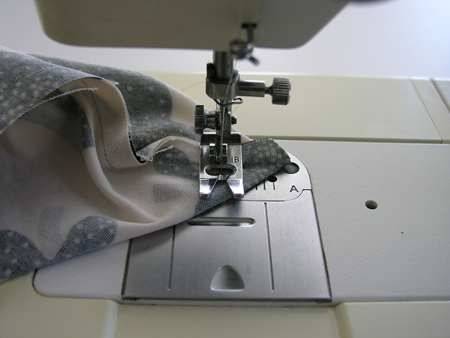
Sew along the line you marked with the pin, backstitching to reinforce at the beginning and end of the seam. Trim away the excess fabric, cutting about 1/4″ from the seam.
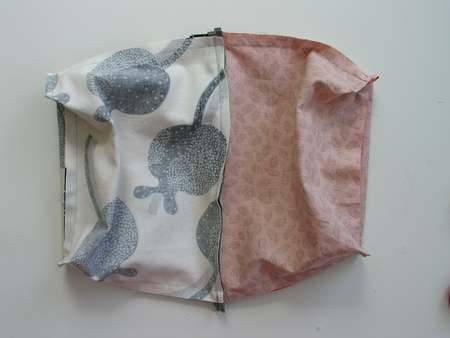
Here’s how the piece will look after you’ve sewn and trimmed all four corners.
12. Turn it right-side out.

Turn the bag right side out, carefully working the bag through the opening you left in the lining. Press all the seams, then sew the lining closed by hand.
Turn the lining to the inside of the bag, and you’re done!
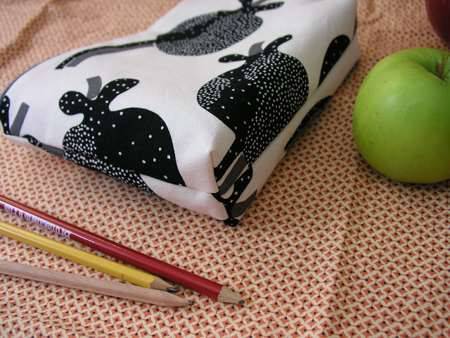
10 notes
·
View notes
Text
Winter Fashion: Must-Have Essentials for the Cold Season
Winter Fashion: Must-Have Essentials for the Cold Season
As winter approaches, it’s the perfect time to refresh your wardrobe with the latest trends and essential pieces that will keep you both warm and stylish. In this comprehensive guide, we’ll delve into the must-have items for winter fashion, ensuring you’re ready to embrace the cold season with confidence and flair.
Layer Up with Trendy Outerwear
Coats and Jackets:
A high-quality coat or jacket is indispensable during winter. Wool coats, parkas, and puffer jackets are timeless choices that offer warmth and style. These pieces are versatile, and easily paired with both casual and formal outfits.
Trench Coats:
For a more polished look, trench coats are a fantastic choice. They can be dressed up or down, making them a versatile addition to any winter wardrobe. Opt for neutral colors like beige, black, or navy to ensure they complement a variety of outfits.

Cozy Knitwear
Sweaters:
Sweaters are the backbone of winter fashion. From chunky knits to soft cashmere, they offer comfort and style. Neutral tones such as gray, beige, and cream are versatile, while bold colors can make a statement.
Cardigans:
Cardigans are perfect for layering and add an extra layer of warmth. They can be worn over t-shirts, blouses, or dresses, making them a versatile piece in your winter wardrobe. Look for styles with interesting textures or patterns to add a unique touch to your outfit.
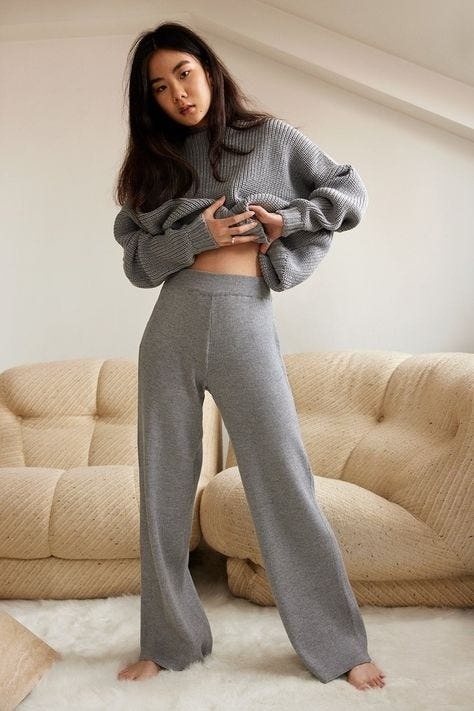
Essential Accessories
Scarves:
Scarves are a functional and stylish accessory, providing warmth and adding a pop of color or pattern to your outfit. Wool and cashmere scarves are the warmest options, and they come in a variety of styles, from chunky knits to lightweight wraps.
Hats and Gloves:
Keeping your head and hands warm is crucial during winter. Beanies, berets, and leather gloves are stylish options that provide both warmth and sophistication.
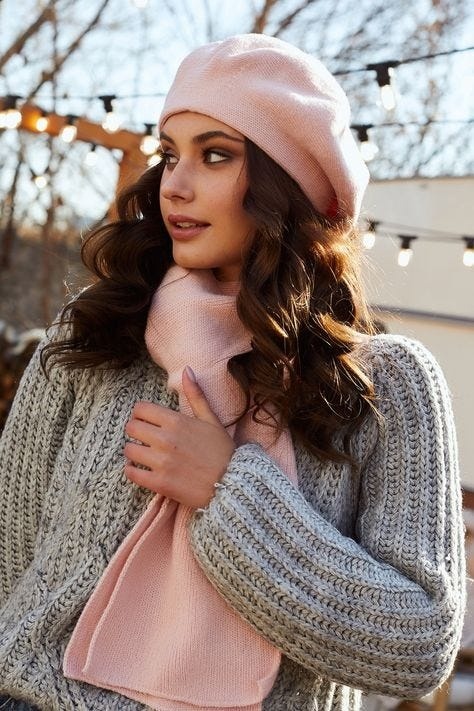
Footwear for Winter
Boots:
A quality pair of boots is crucial for winter. Waterproof options that provide insulation are ideal. Ankle boots, knee-high boots, and combat boots are versatile choices that can be dressed up or down. Look for styles with sturdy soles to navigate icy conditions safely.
Winter Sneakers:
For a more casual look, winterized sneakers offer comfort and style without sacrificing warmth. These are perfect for everyday wear, providing a sporty yet cozy option for your winter wardrobe.

Winter Wardrobe Essentials
Thermal Wear:
Quality thermal tops and leggings are must-haves for winter. They provide an extra layer of warmth without adding bulk, making them perfect for layering under your favorite outfits.
Jeans and Trousers:
Opt for thicker fabrics like corduroy or lined jeans to keep your legs warm. High-waisted styles are particularly popular, offering both warmth and a flattering fit.
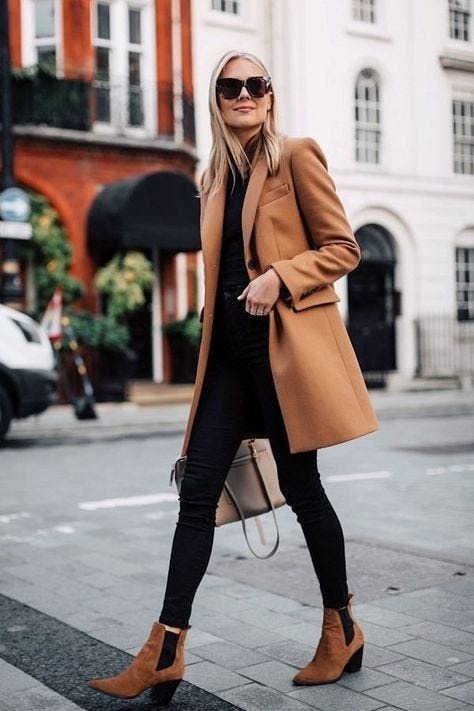
Stylish Dresses for Cold Weather
Sweater dresses
Sweater Dresses are ideal for winter, combining warmth with style. For a complete outfit, pair them with tights and boots. They come in various lengths and styles, from casual to dressy, making them a versatile addition to your winter wardrobe.
Midi and Maxi Dresses:
Long dresses made of heavier fabrics can be layered with turtlenecks or worn under coats for a chic winter outfit. These styles are perfect for transitioning from day to night, offering both comfort and elegance.
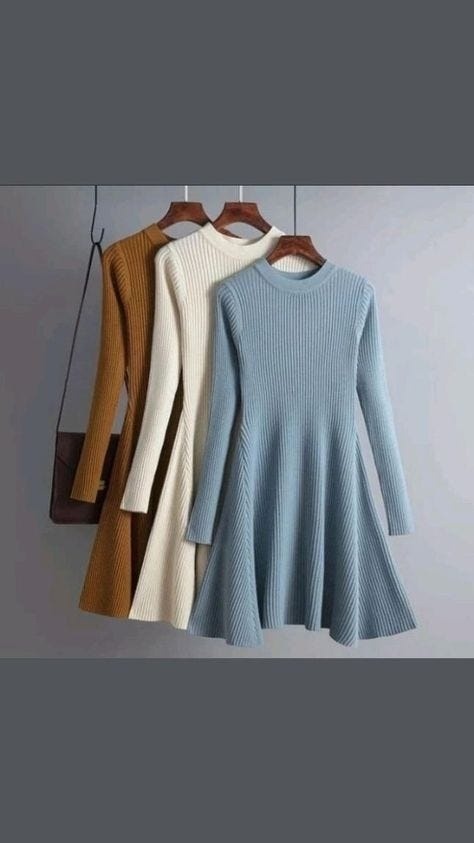
Color Trends for Winter Fashion
This winter, earthy tones, jewel tones, and classic neutrals are in vogue. Earthy shades like olive green, terracotta, and camel are versatile and timeless. Jewel tones like emerald, sapphire, and ruby add a rich, luxurious touch to your wardrobe. Don’t shy away from experimenting with bold colors to brighten up the gray days and make a fashion statement.
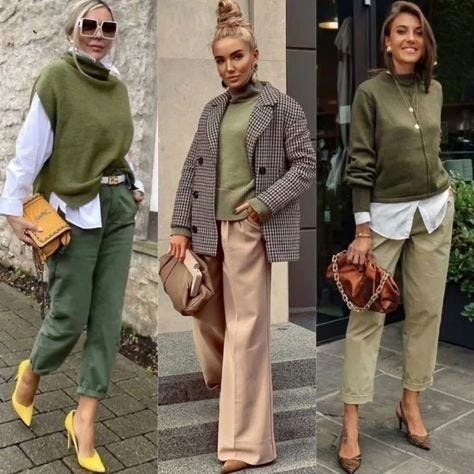
Mix and Match for Versatility
Building a versatile winter wardrobe means investing in pieces that can be mixed and matched to create multiple outfits. A neutral-colored coat can be paired with various scarves, hats, and gloves to create different looks. Similarly, a well-chosen pair of boots can complement everything from jeans to dresses, making them a practical and stylish investment.
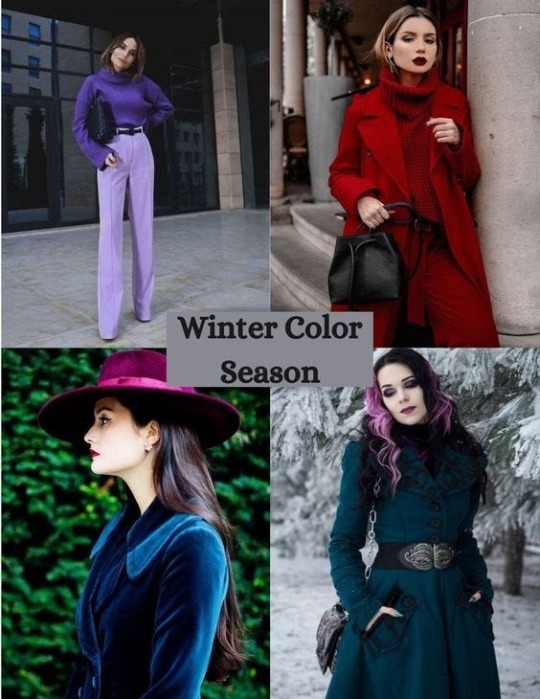
Sustainable Winter Fashion
Consider incorporating sustainable fashion choices into your winter wardrobe. Choose brands that utilize eco-friendly materials and adhere to ethical production practices. Investing in high-quality, timeless pieces can reduce the need for frequent replacements, making your wardrobe more sustainable in the long run.

Conclusion
Winter fashion is all about layering, staying warm, and looking stylish. By incorporating these essential items into your wardrobe, you’ll be ready to face the cold season with confidence and flair. Whether you’re updating your outerwear, adding cozy knitwear, or accessorizing with scarves and hats, staying trendy and cozy is easy with these winter fashion must-haves. Embrace the season with a well-curated wardrobe that combines practicality with style.
2 notes
·
View notes
Text
Costuming Research: Elliott Vale
After the chapter that @ginger-and-mint just put out, the least I can give poor Elliott is a set of costumes. (He would not thank me for it.)
So. This is just about the opposite end of the socio-economic spectrum from Greyson. Elliott is the scion of one of the most powerful families of di-mages, both in terms of political and magical power... and heir to all the pressure and dysfunction that comes with that title.
Elliott's most striking and consistent garment is a black jacket. Sticking with the turn-of-the-century time period laid out in Greyson's post... I'm giving the man an Inverness Cape. You've seen an Inverness Cape before.
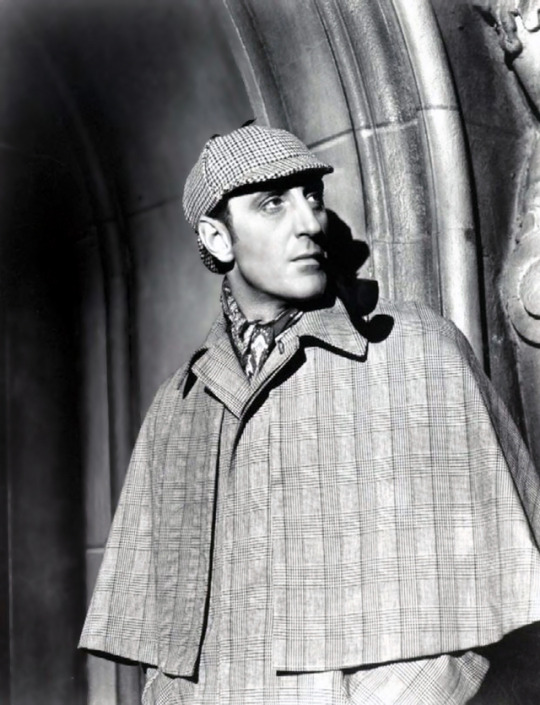
Here's Basil Rathbone as Sherlock Holmes wearing a plaid one.
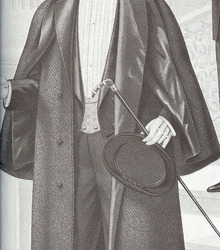
And here's a fashion plate of one from 1901 (Thanks, Wikimedia Commons!)

This one's technically an Ulster Coat, but it's an extremely similar beast.
It's dramatic! It lets you swoop around melodramatically if you're in such a mood! It's a profoundly practical garment, especially if made out of black wool: it can be practically waterproof or snowproof, which is an important factor given Oppendorff's snowy winters. Its silhouette neatly hides the shape of your actual body. (And it's exactly the sort of thing I would have worn at 23 if I hadn't made myself a full circle-cloak, and would have considered the epitome of cool. Still might, actually, if I can ever get the hang of button-holes.)
Under that coat, Elliott is probably wearing high-waisted wool or linen pants (depending on the season), as typical for the turn of the century. (I'm going to have a later post on the specifics of fabric weave/composition, because I have Opinions on how to construct in-period garments with extra stretch to them.)
Elliott is described on his character sheet as "Always dressing in nice clothes, which people chalk up to snobbishness." I would interpret this as him dressing a level more formal than the situation calls for. "The Black Tie Blog" did a fantastic job curating some more formal fashion plates that would be appropriate. I'm including a couple of my favorites here.

We have an Inverness Cape on the left! And such nice high collars! (This set is from 1894). I'm a little torn on whether Elliott would go for waistcoats: on the one hand, wearing one when the occasion doesn't call for it would add another dimension of apparent snobbishness, on the other hand, he's generally hiding under his black coat anyway, and having an additional restrictive garment wouldn't' really help with his di-mage casting.
And, in honor of the latest chapter, we should look at some turn-of-the-century sweaters. These are courtesy of "The Victorian Dancer." Now, it's possible that Elliott would end up with something fairly simple: the Vales don't exactly seem like a "knitted sweaters from the aunts" type family.

This ad from 1899 gives a few options available for sale.
But honestly? I want to put him in something more intricate, with some pretty cabling, like this Guernsey sweater:

Next time, let's dig into someone with potential for some interesting folk designs in his outfit: Bramley Nubbins, and the fun of folk art and embroidery in shepherding communities.
#G&M Costume Analysis#I mostly wrote this one because of the Inverness Cape#Everyone should look at Inverness Capes more often#They're just cool garments.
3 notes
·
View notes
Note
formal: What's your OC's formal look? Do they like dressing up? Do they have different looks for different occasions?
informal: What's your OC's lazy-day look? How do they like to dress when they're winding down?
outerwear: What's your OC's outerwear situation? Jacket, sweater, cloak? What sort of weather do they deal with most and how do they protect themselves?
footwear: What does your OC wear on their feet? Here! Have several in case I missed you answering them!
oc asks: character design edition

formal: What's your OC's formal look? Do they like dressing up? Do they have different looks for different occasions? Briar doesn't have a lot of experience with anything formal so he doesn't have much of a 'formal' look. However, if he was asked to, he'd probably do his best to wear his best clothing and be as neat and presentable as he knew how to be. Unfortunately, most of his clothing is handmade so none of it is very 'fancy' but he does his best.
However, if he had the chance to be exposed to fabrics like silk and the option to have some nicer clothing, Briar would likely jump at the chance. He'd save it for special occasions, but he loves the feel of soft and smooth fabrics and would no doubt build himself a decent little collection.
informal: What's your OC's lazy-day look? How do they like to dress when they're winding down? Briar doesn't have many truly 'lazy days' simply due to living alone and on a little homestead with plenty of plants and animals to take care of each day. However, he does have easier days where he can stay indoors other than a few times to check on the animals and he does enjoy them when he can. If he doesn't have to do any heavy work or hunting, Briar likes to wear loose, warm shirts and pants that he can lounge in bed or on the floor with. Normally, they are from soft wool that he spun himself, which is quite cosy when he's baking, reading, or knitting.
During his normal day after everything is done and he's in for the night, Briar usually washes up and likes to dress in light comfortable linen pyjamas during warm months and soft wool ones when not. When it's fall and winter, he also loves the comfy knee-high socks he's made for himself and usually pads around in those during his evenings. He likes to let his hair down and make some tea, curl up and just relax since most of his days are pretty active.
outerwear: What's your OC's outerwear situation? Jacket, sweater, cloak? What sort of weather do they deal with most and how do they protect themselves? Briar is seldom without his mother's green hooded ruana cloak. Even when it's warm, he often wears it, just in case. Fortunately in the Twelveswood, it doesn't often get terribly hot.
Being from the South Shroud, Briar doesn't have to deal with extreme weather too often. The summers are reasonably warm and sunny, but not overly so. The winters have some snow and ice, but it is rare for particularly bad snowstorms. The worst they have to deal with is some strong rains, which can be cold depending on the time of year but are most dangerous due to flooding.
Briar's cloak is waterproof and if he's wearing any protective leathers, they are also waxed to keep them from getting soaked and damaged by heavy rains. Even wool clothing is actually quite good at managing rain, even if there is a bit of a 'woolly' smell while damp.
footwear: What does your OC wear on their feet? Briar actually prefers to be barefoot if he can get away with it. He likes to feel the earth under his feet and he can move more easily on various terrains, including trees. Having run around barefoot since he was small, Briar's feet are actually quite tough and he can handle a lack of shoes fairly easily.
That said, he's not stubborn about it and if it's going to be particularly cold, particularly hot, or a city, he definitely wears shoes. He doesn't want to step on broken glass, get frostbite, or burn his feet on Thanalan sands. He doesn't much like wearing boots though, finding them rather confining even when well-fitting.

@pinxli - thank you for the asks! <3
6 notes
·
View notes